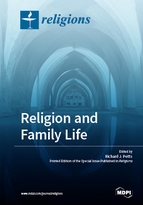Religion and Family Life
A special issue of Religions (ISSN 2077-1444).
Deadline for manuscript submissions: closed (15 January 2019) | Viewed by 105027
Special Issue Editor
Special Issue Information
The aim of this special issue is to examine how various aspects of religiosity and spirituality may facilitate positive family outcomes as well as contribute to negative family outcomes. In doing so, research in this special issue will increase our understanding of religion and family life by further considering the intersection of these influential social institutions.
Dear Colleagues,
There has been increased interest among scholars in recent decades focused on the intersection of family and religion. Yet, there is still much that is not well-understood in this area. This aim of this special issue is to further explore the influence of religion on family life. In particular, the focus of this issue is to bring together leading scholars to consider ways in which religion and spirituality may influence various aspects of family life including family processes, family structure, family formation, family dissolution, parenting, and family relationships. Scholars are encouraged to utilize various aspects of religiosity and spirituality (moving beyond religious affiliation and religious attendance) to focus on the ways in which religiosity may facilitate positive family outcomes as well as ways in which religiosity may also contribute to negative family outcomes. Research examining whether religiosity mediates or moderates family processes on other outcomes is also welcome.
Prof. Dr. Richard J. Petts
Guest Editor
Manuscript Submission Information
Manuscripts should be submitted online at www.mdpi.com by registering and logging in to this website. Once you are registered, click here to go to the submission form. Manuscripts can be submitted until the deadline. All submissions that pass pre-check are peer-reviewed. Accepted papers will be published continuously in the journal (as soon as accepted) and will be listed together on the special issue website. Research articles, review articles as well as short communications are invited. For planned papers, a title and short abstract (about 100 words) can be sent to the Editorial Office for announcement on this website.
Submitted manuscripts should not have been published previously, nor be under consideration for publication elsewhere (except conference proceedings papers). All manuscripts are thoroughly refereed through a double-blind peer-review process. A guide for authors and other relevant information for submission of manuscripts is available on the Instructions for Authors page. Religions is an international peer-reviewed open access monthly journal published by MDPI.
Please visit the Instructions for Authors page before submitting a manuscript. The Article Processing Charge (APC) for publication in this open access journal is 1800 CHF (Swiss Francs). Submitted papers should be well formatted and use good English. Authors may use MDPI's English editing service prior to publication or during author revisions.
Keywords
- family
- religion
- religiosity
- spirituality
- family processes
- family structure






